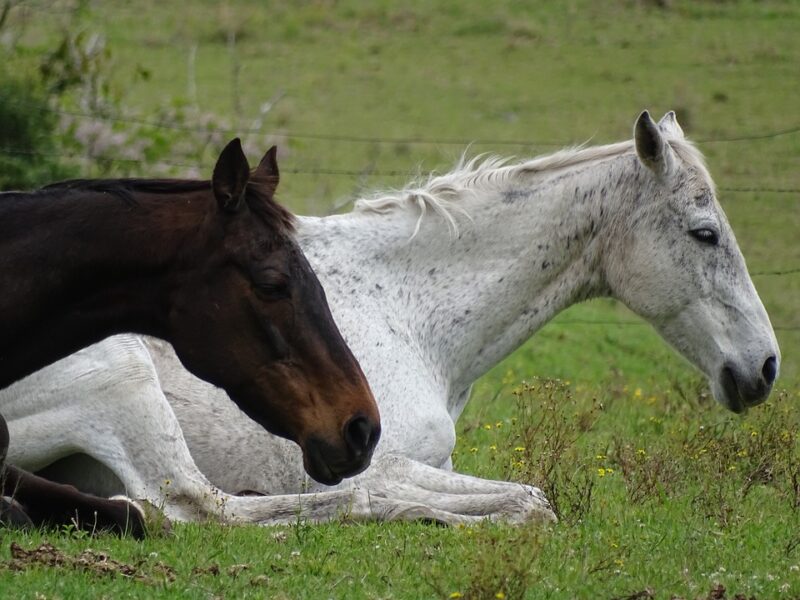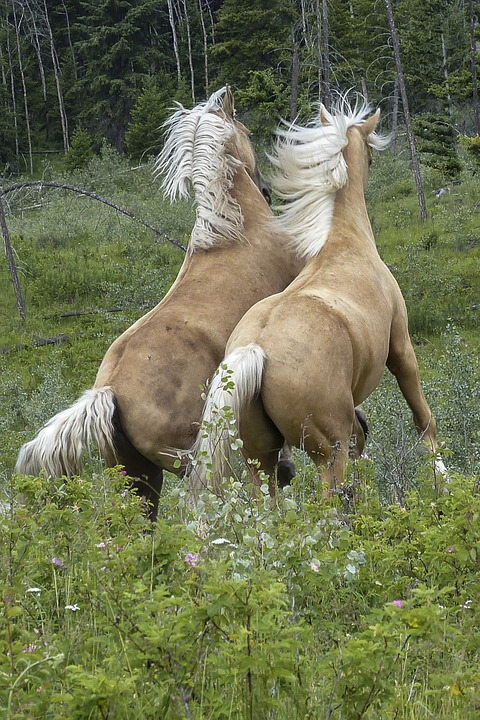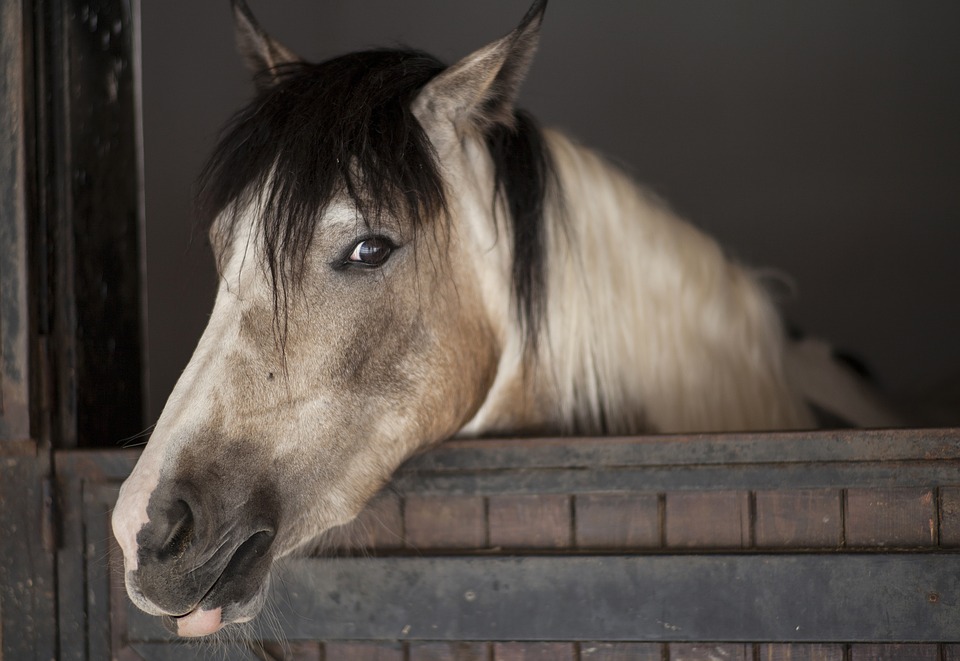One of the first things that any budding equestrian learns about horses is that they are herd animals. But that means much more than that horses can be found in groups like cattle and antelope. The social system of horses is unique and complex just like human social arrangements, and it’s vital to equine well-being to provide for a correct group lifestyle so that social behaviors can occur at the right frequency.
Herd Living

Feral horses, and domestic horses living in large and minimally-managed groups, live in small herds or bands known as harems. The wild condition for horses is for a group of mares and their offspring – both foals and “teen” or younger adults – to live alongside one or more stallions. These groups of horses can be quite small, with just a few horses, or up to about twenty. The horses live and travel together, moving in search of resources like food and water, and avoiding predators.
Offspring leave this group to join other bands or start their own, and stallions compete for breeding rights and may lose the “top spot” in their harem in fights with other males.
In domesticated living, horses can’t usually have a perfectly natural harem lifestyle – for many good reasons, the greatest of which is to control breeding. While breeding behaviors such as courtship and mating are probably very important to horses and their social arrangements, it’s almost always inappropriate to house minimally-managed harems of intact horses because of the inevitable production of offspring. The importance of breeding to overall equine mental wellbeing and welfare is poorly studied and, for good reasons, most male domesticated equines are gelded early in life.

The absence of herd breeding is one major difference between feral equines and those living in human care, but the other aspects of herd lifestyle can and should still be offered to horses. Herds are safer from predators than single horses, so housing horses in groups promotes a natural feeling of security that can’t be mimicked by simply housing a single horse in a “safe paddock.” Keeping groups of horses together is a form of enrichment that is also a basic tenet of horse care. To give your horse the most natural lifestyle possible, allow them to live in groups that share the same space rather than stalling or offering single-horse turnout.
Making Noise: Vocal Communication
Horses make a variety of sounds to communicate with one another. Housing horses together is the best way to encourage expression of vocal behaviors naturally, since these are behaviors that need to occur within a very specific context.
Just as humans say “hello!” and not “This banana is blue” when meeting a new person, horses make certain sounds as part of certain interactions. The familiar whinny or neigh is used to signal location, and horses use neighing to detect where other horses are in relation to themselves – often when they can’t see the other horse, such as when one horse is in the barn while the other is in a paddock.
Nickers
Nickering is a low-pitched, soft equine sound used in a few different contexts. Mares and foals nicker to each other and stallions may make this sound during courtship, but most of the time we hear nickering when horses know it’s feeding time, or occasionally when they nicker to humans that they have positive relationships with.
Snort
Snorting is an alarm sound that usually accompanies a flight response (running away), and can occur very quickly when a horse detects something that might be a threat. It’s easy to recognize a snort because of the abrupt noise and forceful blow of air from the nostrils. Sometimes, snorting can occur when the horse sees an unfamiliar or possibly threatening object, and at other times it may be a response to a smell that humans can’t detect. Sometimes, snorting occurs during play.
Squeal
Squealing is an agonistic behavior, which means it occurs in the context of possible aggression or violence between animals. It’s a really interesting communication between horses that can be seen in a variety of contexts. Often, when two horses meet for the first time, you can observe them smelling one another closely, standing rigidly, and then possibly squealing, often with a quick jerk of the head and separation of individuals. This is a normal social exchange and often doesn’t result in more agonistic behavior between the animals.
Mares are known for squealing during their heat cycles, a time when their behavior patterns change as they undergo estrus and prepare for possible breeding. While squealing can be alarming to people, the “squeal stigma” associated with this sound is largely a human construct. It doesn’t indicate that a horse is poorly trained, unresponsive or “disrespectful” to the person handling it, or other common labels. Squealing can indicate that aggression may occur between horses, but often is the only signal needed between two horses that then settle down or offer appeasement signs instead. Enrichment is generally not used to encourage this behavior, but some techniques can be used to decrease its incidence – but only if the squealing is truly excessive rather than simply a normal social exchange between horses. In this case, finding out why a horse is performing the behavior out of context or to excess is important so that the underlying problems can be resolved.
We don’t usually encourage vocalization with enrichment because simply providing horses with the correct social environment produces ample opportunity for them to vocalize to one another. Additionally, vocalizations shouldn’t be punished or discouraged as they are usually performed for a reason, even if that reason doesn’t make sense to humans at first glance. If your horse doesn’t have the opportunity for group living, consider this as the first change you can make to your horse’s lifestyle – you’ll get to hear fewer anxious neighs and a lot more gentle nickers and know that you’ve improved the welfare of your equine companion.
Nonvocal Communication: Body Language

Behaviors involving body language are vital tools by which horses communicate. Most horses interpret one another’s body language easily and accurately, but humans occasionally have a harder time doing so. Often, we miss subtle signals of communication, especially regarding equine fear, discomfort, and appeasement signals, or misinterpret equine body language. Encouraging our horses to express themselves, and being able to correctly interpret their signals, is an important component of behavioral care because it can result in greater mental wellbeing for horses.
Horses have facial expressions that can indicate their emotional state. Ears, eyes, nostrils, and the tension of the muscles in the face work together to express different feelings or intentions, from relaxation to panic or rage and everything in between.
The position and posture of the body is a form of communication between horses. Equines can approach or retreat from others and adjust the carriage of the head and neck to signal aggression or appeasement. Turning the head and neck away from a stimulus can often be a sign that the horse is uncomfortable with the situation. Certain calming gestures or appeasement signals exist in horses as subtle forms of communication, such as bending forward to touch the foreleg with the nose. Horses also use their tails for communication, changing the position of the tail along with their emotional state.
When approaching body language and other communication behaviors from a behavioral care perspective, we should always keep in mind that communication behaviors exist for a reason. Often, when high-intensity forms of communication occur between horses and humans- such as aggressive body language and threat signals – it is because less intense communication has been ignored or punished by humans. Imagine yourself quietly attempting to get someone’s attention while being calm and polite but having no success; eventually, you’ll need to raise your voice or tap the person on the shoulder to be understood. Horses are the same way and will “get louder” in their expressions when their “polite” equine-specific communication behaviors aren’t understood by humans. If punishment is applied when horses communicate with humans in certain ways (a good example is threatening to smack or swat a horse when it pins its ears at a person), additional changes in the horse’s communication behaviors can occur as a result.
The best way to encourage all your horse’s communication tools, including the subtle ones, is to be a good listener and resolve any underlying issues that cause a horse to exhibit body language that we perceive as undesirable. If your horse’s communication behaviors involve expressing fear, you can figure out what causes their anxiety and develop strategies to help them overcome it or change their situation to a more comfortable one. If their body language indicates pain or frustration, the same approach can help you address physical and environmental conditions, or elements of your training and handling, that you can adjust to make your horse more comfortable.